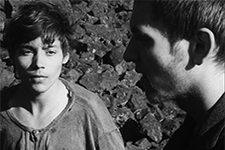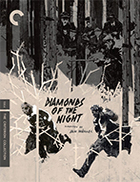Diamonds of the Night (Démanty noci)
|  Jan Nèmec’s directorial debut Diamonds of the Night (Démanty noci) begins with an astounding two-minute tracking shot—often referred to as the most complicated tracking shot in the history of Czech cinema. It throws us immediately into the action, as we watch two boys (Ladislav Jánsky and Antonín Kumbera), having just leapt from a freight train that we can hear just off-screen and briefly glimpse, run along the edge of a dense forest, shedding their heavy coats as they scramble up a steep hillside littered with shorn tree trunks. The camera tracks closely alongside them as voices yell from behind and gunshots ring out; the smoothness of the camera movement contrasts with the boys’ wild, fraught movements as they run and claw their way up the hill (this being pre-Steadicam, the shot was achieved by building a massive track with the camera on multiple carts, some of which acted as counterbalances for the movement up the hill). The camera eventually joins their desperation, shifting to a handheld modality that reflects the intensity of their desperation. The shot mixes both intense, physical realism and a purposefully disorienting use of space, as Nèmec and his cinematographer Jaroslav Kucera keep the camera at the same angle as the boys, which makes their climbing up the hill appear as if they are crawling on all fours on level ground. It is the first hint that Nèmec is not going to maintain any kind of fidelity to physical reality, but rather use the story of the boys’ escape as a leaping-off point for an experiment in cinematic subjectivity. We later learn that the train from which the boys escaped was taking them to a concentration camp, and their initial escape is just the beginning of a fraught journey to what they can only hope will be eventual freedom. Working from a slim novel by Arnošt Lustig, who himself survived both Auschwitz and Buchenwald and escaped from a freight train carrying him to Dachau, Nèmec depicts the boys’ as being constantly in danger, not just from Nazi troops, but from the grizzled old farmers who work the countryside through which they are running. Working with the Nazis, they assemble a hunting party to go after the boys, showing in no uncertain terms how the horrors of the Holocaust were enabled by collaborators who never officially put on a uniform. Nèmec depicts these collaborators in as grotesque a manner as possible, particularly in his emphasis on their celebratory eating and drinking when the boys are captured, which is not only vulgar in its own right, but all the more cruel given our understanding of how desperate and starving the boys are. The sense of human cruelty on display grounds the film’s unconventional aesthetic flights, reminding us that Nèmec is not interested in experimentation for its own sake, but rather as a means of getting at deeper, darker truths about human nature. Diamonds of the Night was one of a number of Czech films at the time to depict the Holocaust—which also include Zbynek Brynych’s Transport From Paradise (Transport z ráje, 1963), Ján Kadár and Elmar Klos’s The Shop on Main Street (Obchod na korze, 1965), and Antonín Moskalyk’s Dita Saxová (1968)—the result of the post-Stalin Soviet Union easing some of its restrictions on filmmakers in its Eastern European satellite countries. Unlike most other Czech Holocaust films, Nèmec’s largely eschews a traditional cinematic approach to the subject and instead dramatizes the action through a fractured subjectivity that renders the entire experience dreamlike and fleeting—ruthlessly subjected it to a surreal nightmare logic that often leaves us questioning whether events actually transpired (in this way, his film is evocative of the works of Alain Resnais, particularly 1959’s Hiroshima mon amour). It is a particularly compelling example of Nèmec’s assertion that “the director must create his own world, a world independent of reality, as it appears the time” (his resistance to traditional cinematic approaches is likely why he did not achieve the same prominence as some of his contemporary Czech New Wave filmmakers such as Milos Forman and Ivan Passer, both of whom made their way to Hollywood). There is a clear narrative from beginning to end involving the boys’ escape, but that narrative is punctuated throughout with both flashbacks and various dreams and fantasies, which makes the film more of a psychological meditation on stress and survival than a linear story about escape. It challenges our expectations at virtually every turn, including its multiple endings that leave the fate of the boys in limbo.
Copyright © 2019 James Kendrick Thoughts? E-mail James Kendrick All images copyright © The Criterion Collection | |||||||||||||||||||||||||||||||
Overall Rating: 


 (3.5)
(3.5)


